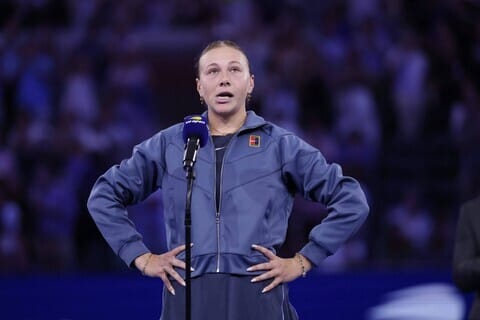- Action Line by Brendan Fernandes
- Posts
- The Art of Defeat: Tennis's Unique Runner-Up Speech Tradition
The Art of Defeat: Tennis's Unique Runner-Up Speech Tradition

The Athletic's article by Charlie Eccleshare examines the unique tennis tradition of Grand Slam runner-up speeches, focusing on the 2025 U.S. Open women's final between Aryna Sabalenka and Amanda Anisimova. The piece explores how these immediate post-defeat addresses create raw, vulnerable moments that reveal athletes' character while subjecting them to emotional scrutiny unlike any other sport.

The article frames its analysis through recent notable speeches, including Sabalenka's controversial self-critical speech after losing the French Open to Coco Gauff, and Anisimova's emotional five-minute address following her 6-0, 6-0 Wimbledon final loss to Iga Świątek. After Sabalenka's 6-3, 7-6(3) victory at the U.S. Open, both players delivered speeches that reflected their evolving approaches to this challenging tradition.
Tennis stands alone in requiring defeated finalists to immediately articulate their feelings while witnessing their opponent's triumph. This ritual forces players to rapidly transition from competitive intensity to gracious sportsmanship, creating a tension between genuine emotion and expected decorum. As oratory expert Michael Ronayne notes, "We're asking them to bleed in front of us," highlighting the voyeuristic nature of the tradition.
The article identifies distinct approaches players develop to manage these moments: some prepare notes (like Naomi Osaka), others embrace vulnerability (Andy Murray), while some balance honesty with respect (Novak Djokovic). These strategies reflect each player's personality and emotional processing style, with the most memorable speeches often revealing genuine vulnerability rather than polished perfection.
The structure creates a fascinating dichotomy between what players genuinely feel and what tennis etiquette demands. Frances Tiafoe's candid admission - "I'd love to be like, 'I don't like you'" - highlights this tension between authentic emotion and expected graciousness. The article questions whether this tradition, while providing compelling human moments, might be unnecessarily cruel to athletes at their most vulnerable.
Beyond individual coping strategies, these speeches serve as character-defining moments that can transform public perception. Murray's tearful 2012 Wimbledon speech following his fourth consecutive Grand Slam final loss became a turning point in his relationship with fans. Similarly, Anisimova's graceful response to her Wimbledon double-bagel defeat earned her admiration despite the humiliating loss.
The tradition raises broader questions about emotional authenticity in sports. While tennis has conditioned audiences to expect gracious losing, the article suggests there might be value in allowing more authentic expressions of disappointment or creating space between defeat and public reflection. As former champion Jim Courier notes, "It's almost cruel what we ask our athletes to go through."
These speeches ultimately reveal that athletic excellence and emotional articulation require different skills. The tradition creates an additional challenge unique to tennis - demanding players not only compete at the highest physical level but also demonstrate exceptional emotional resilience and public speaking ability in their most disappointing moments.

